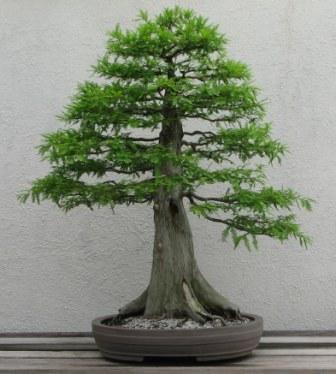Linda’s recent post on the sustainability of topiaries got me to thinking, is any horticultural practice sustainable? And, does it matter?

Picking up on the topiary theme I thought of the ultimate form of tree manipulation, bonsai. I few years ago I visited the National Arboretum in Washington DC, which includes an incredible bonsai display. Some of the bonsai specimens in the collection originated in Japan and are over 300 years old. Is 300 years long enough to consider this a sustainable practice? Does it matter as long as there are individuals willing to devote the time and effort to tend and prune these awesome and inspiring plants?

More recently I visited the International Rose Garden at Washington Park in Portland. Established over 90 years ago the garden is one of the premier attractions in Washington Park and in Portland. Maintaining the garden, however, requires paid staff and an army of volunteers. Is 90 years long enough to consider this sustainable? Does it matter as long as the city is willing to commit resources and volunteers are willing to line up to dead-head and pull weeds?

Closer to home, I maintain about an acre of my place in lawn and various beds – trees, shrubs, herbaceous perennials and even a few (gasp) annuals. Is this sustainable? Does it matter as along as my family and I enjoy our surroundings and are willing to commit the time and effort to mow, weed, edge, prune and dead-head?
Bert, the issue I have is with “full disclosure.” Sure, I think most if not all of us probably have a portion of our gardens or landscapes that need higher maintenance, and that’s just fine. My problem is with an uninformed public who think that a topiary is just going to stay that way without constant pruning. The same goes for any tree or shrub that’s been artificially pruned to meet some unnatural standard. The quote many arboriculturists like comes from The Little Prince: “You become responsible, forever, for what you have tamed.”
It is really about education — in Japan, virtually ALL trees and shrubs in private gardens are heavily pruned and sculpted, and they look consistently great stunning because sheering shrubs is as ingrained in their culture as mowing the lawn is in ours. Here, where most people don’t know much about pruning, I see a lot of formerly pretty topiaries that now look wretched.
Sustainability: Virtuous or Vulgar?
Commentary here.
Ray:
Thanks for the interesting links. I am really interested in readers opinions on how they define sustainability (yes, I realize there are lots of definitions on the web) but how do we internlize it? From an ornamental horticulture perspective, what make a practive sustiable? How do we know when we acheive it? Can we know? Or is all this just greenwashing?
I wrote “Sustainable Gardening for Florida” which was published last fall by University Press of Florida. So I’ve thought a great deal about this topic.
Without the continuing hand of the gardener, Mother Nature works to equalize any gardened space to its surroundings. By definition then, a garden is not self-sustaining. So… what the heck is sustainable gardening?
I defined sustainable gardening and sustainable landscape management as a wide-ranging collection of techniques that reduce your gardening footprint on the planet. I summarized them into eight categories.
1) Have minimal impact on the environment by using little or no artificially produced chemicals, (pesticides, herbicides, quick-release fertilizers) and by reducing the use of powered devices in the care of the landscape.
2) Make the best use of available resources. Use rain barrels to collect rainwater; don’t over water; mulch bare soil to preserve moisture; and enrich soil with compost.
3) Save time and money. Use good gardening techniques so you don’t have to replace your plants later. Reduce the size of your lawn and manage what’s left in a more natural manner.
4) Reduce carbon dioxide and increase oxygen in the air by installing more large plants. Greater plant biomass increases the amount of photosynthesis.
5) Offset some of the heat absorbed and stored by urban/suburban buildings, and roads. Landscaping with more trees, shrubs, and understory perennials reduces the air temperature in the immediate vicinity.
6) Increase habitat for wildlife including birds, bees, butterflies, and other critters. The sustainable landscape supports an active ecosystem where plants, microbes, insects, and other animals all depend on one another.
7) Prevent damage to infrastructure. Don’t start digging until you know the location of underground utilities, and pipes. Also look up to locate overhead wires, and plan your landscape to avoid them. It’s definitely not sustainable to remove or top a tree because you didn’t plan ahead.
8) Prepare for disasters such as hurricanes, fires, and drought. While there are no guarantees, designing your landscape to minimize damage when a disaster strikes is sustainable.
I take issue with the idea that topiaries are somehow bad just because the buyer doesn’t expect them to get bigger. It’s a plant…it grows. The uninformed public should inform themselves or ask questions or buy from someplace worth a hoot that has a sales staff that will properly educate them. It’s not my job to idiot proof plants. Yes, plants benefit from proper pruning and planting…they require water too, but I don’t think I should have to put that on the tag. Where do we draw the line about what people should reasonably be expected to know? That it will get bigger falls on the “they should expect it” side of that line for me.
Paul, I don’t think topiaries are “bad.” I mentioned in my earlier post that I enjoy formal gardens a lot. My issue is with an industry that one on hand claims it’s becoming sustainable, but on the other hand creates high-maintenance plants for a largely uninformed public. That seems hypocritical – sustainability (however one interprets the word) doesn’t end once the product is shipped to the retail nursery.